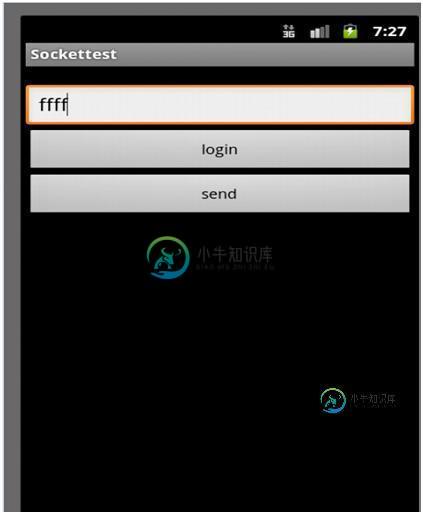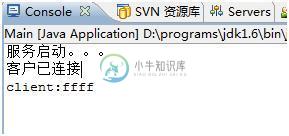Android中Socket的应用分析
本文实例分析了Android中Socket的应用。分享给大家供大家参考,具体如下:
Android 提供的常用的网络编程包括针对TCP/IP协议的Socket通信。Socket是一种跨平台的编程方式,可以在异构语言之间进行通信。
Socket程序的开发原理,是要实现服务器端和客户端。
服务器,使用ServerSocket监听指定的端口,端口可以随意指定(由于1024以下的端口通常属于保留端口,在一些操作系统中不可以随意使用,所以建议使用大于1024的端口),等待客户连接请求,客户连接后,会话产生;在完成会话后,关闭连接。
客户端,使用Socket对网络上某一个服务器的某一个端口发出连接请求,一旦连接成功,打开会话;会话完成后,关闭Socket。客户端不需要指定打开的端口,通常临时的、动态的分配一个1024以上的端口。
下面是一个实现socket的例子:
服务器端代码:
package com.socket;
import java.io.BufferedReader;
import java.io.InputStream;
import java.io.InputStreamReader;
import java.io.OutputStream;
import java.io.PrintWriter;
import java.net.ServerSocket;
import java.net.Socket;
/**
* com Server
*/
public class Main {
private int ServerPort = 9999;
private ServerSocket serversocket = null;
private OutputStream outputStream = null;
private InputStream inputStream = null;
private PrintWriter printWinter = null;
private Socket socket = null;
private BufferedReader reader = null;
public Main(){
try{
serversocket = new ServerSocket(ServerPort);
System.out.println("服务启动。。。");
socket = serversocket.accept();
System.out.println("客户已连接");
}catch(Exception ex){
ex.printStackTrace();
}
try{
outputStream= socket.getOutputStream();
inputStream = socket.getInputStream();
printWinter = new PrintWriter(outputStream,true);
reader = new BufferedReader(new InputStreamReader(inputStream));
BufferedReader in = new BufferedReader(new InputStreamReader(System.in));
while (true){
String message = reader.readLine();
System.out.println("client:"+message);
if(message.equals("bye")||message.equals("Bye")){
break;
}
message = in.readLine();
printWinter.println(message);
}
outputStream.close();
inputStream.close();
socket.close();
serversocket.close();
System.out.print("Client is disconnected");
}catch(Exception e){
e.printStackTrace();
}finally{
}
}
public static void main(String[] args){
new Main();
}
}
客服端代码:
package com.Aina.Android;
import java.io.BufferedReader;
import java.io.BufferedWriter;
import java.io.InputStreamReader;
import java.io.OutputStreamWriter;
import java.io.PrintWriter;
import java.net.Socket;
import android.app.Activity;
import android.app.AlertDialog;
import android.content.DialogInterface;
import android.os.Bundle;
import android.os.Handler;
import android.os.Message;
import android.util.Log;
import android.view.View;
import android.widget.Button;
import android.widget.EditText;
import android.widget.TextView;
public class Test extends Activity implements Runnable {
/** Called when the activity is first created. */
private TextView tv_msg = null;
private EditText ed_msg = null;
private Button btn_send = null;
private Button btn_login = null;
private static final String HOST = "192.168.0.132";
private static final int PORT = 9999;
private Socket socket = null;
private BufferedReader in = null;
private PrintWriter out = null;
private String content = "";
@Override
public void onCreate(Bundle savedInstanceState) {
super.onCreate(savedInstanceState);
setContentView(R.layout.main);
tv_msg = (TextView) this.findViewById(R.id.TextView);
ed_msg = (EditText) this.findViewById(R.id.EditText01);
btn_login = (Button) this.findViewById(R.id.Button01);
btn_send = (Button) this.findViewById(R.id.Button02);
try {
socket = new Socket(HOST, PORT);
in = new BufferedReader(new InputStreamReader(socket
.getInputStream()));
out = new PrintWriter(new BufferedWriter(
new OutputStreamWriter(socket.getOutputStream())),
true);
} catch (Exception ex) {
ex.printStackTrace();
ShowDialog("登陆异常:" + ex.getMessage());
}
btn_send.setOnClickListener(new Button.OnClickListener() {
public void onClick(View v) {
// TODO Auto-generated method stub
String msg = ed_msg.getText().toString();
if (socket.isConnected()) {
if (!socket.isOutputShutdown()) {
out.println(msg);
}
}
}
});
new Thread(this).start();
}
public void ShowDialog(String msg) {
new AlertDialog.Builder(this).setTitle("提示").setMessage(msg)
.setPositiveButton("OK", new DialogInterface.OnClickListener() {
public void onClick(DialogInterface dialog, int which) {
// TODO Auto-generated method stub
}
}).show();
}
public void run() {
try {
while (true) {
if(socket.isConnected()){
if(!socket.isInputShutdown()){
if ((content = in.readLine()) != null) {
Log.i("TAG", "++ "+content);
content += "\n";
mHandler.sendMessage(mHandler.obtainMessage());
}else{
}
}
}
}
} catch (Exception ex) {
ex.printStackTrace();
}
}
public Handler mHandler = new Handler() {
public void handleMessage(Message msg) {
super.handleMessage(msg);
Log.i("TAG", "-- "+msg);
tv_msg.setText(tv_msg.getText().toString() + content);
}
};
}
XML文件布局:
<?xml version="1.0" encoding="utf-8"?> <LinearLayout xmlns:android="http://schemas.android.com/apk/res/android" android:orientation="vertical" android:layout_width="fill_parent" android:layout_height="fill_parent"> <TextView android:id="@+id/TextView" android:singleLine="false" android:layout_width="fill_parent" android:layout_height="wrap_content" /> <EditText android:hint="content" android:id="@+id/EditText01" android:layout_width="fill_parent" android:layout_height="wrap_content"> </EditText> <Button android:text="login" android:id="@+id/Button01" android:layout_width="fill_parent" android:layout_height="wrap_content"> </Button> <Button android:text="send" android:id="@+id/Button02" android:layout_width="fill_parent" android:layout_height="wrap_content"> </Button> </LinearLayout>
先启动服务器端,再运行客户端程序。
注意:
(一)即使服务器端和客户端在一台机器上运行,也不能使用ip地址:127.0.0.1,否则,程序会出现拒绝连接的错误。
(二)客户端和服务器端最好不要建在一个工程下,最好是分别建立工程,然后启动服务器端和客户端,否则会报Error: ShouldNotReachHere()错误。这是因为Android程序不是已main方法为程序的入口。
运行效果:


更多关于Android相关内容感兴趣的读者可查看本站专题:《Android通信方式总结》、《Android调试技巧与常见问题解决方法汇总》、《Android开发入门与进阶教程》、《Android多媒体操作技巧汇总(音频,视频,录音等)》、《Android基本组件用法总结》、《Android视图View技巧总结》、《Android布局layout技巧总结》及《Android控件用法总结》
希望本文所述对大家Android程序设计有所帮助。
-
我是节点js&socket.io的新手。给我一个如何解决这个问题的架构指南。提亚。 我的app.js代码:
-
问题内容: 据我所知,目前大多数android教程和示例都依赖于GCM的使用,以将数据从服务器发送到android设备。并使用php脚本和post / get方法将数据从设备发送到服务器。 我的一个朋友(对Android编程一无所知的人)只是问我,为什么我们不能在Java中使用Socket类?在传统的Java编程中,您使用套接字(IP地址+端口号)来实现类似于GCM的功能(单个服务器多个客户端-
-
本文向大家介绍Android LayoutInflater深入分析及应用,包括了Android LayoutInflater深入分析及应用的使用技巧和注意事项,需要的朋友参考一下 LayoutInflater解析 前言: 在Android中,如果是初级玩家,很可能对LayoutInflater不太熟悉,或许只是在Fragment的onCreateView()中模式化的使用过而已。但如果稍微有些工作
-
我正在为离我很远的人开发一个应用程序。我在用Android Studio。我的老板想在他们的手机上试用这个应用程序,但是我的老板没有android studio,也不知道如何使用Git。我如何在他们的手机上获得应用程序?有没有一种方法可以访问应用程序文件,以便它们可以很容易地放在手机上?
-
问题内容: 当我尝试通过其Closeable接口关闭套接字时,出现异常: 这是为什么?该问题仅在Android设备上,而不在桌面上运行的Java程序上。 问题答案: 引用Android问题跟踪器: 套接字仅从API级别19(kitkat)起才实现Closeable,但是该信息不在生成的文档中。
-
我经常看到使用套接字的服务器程序的示例代码。 (为了简单起见,这里我不检查函数的返回值,如socket()或bind()等。)

